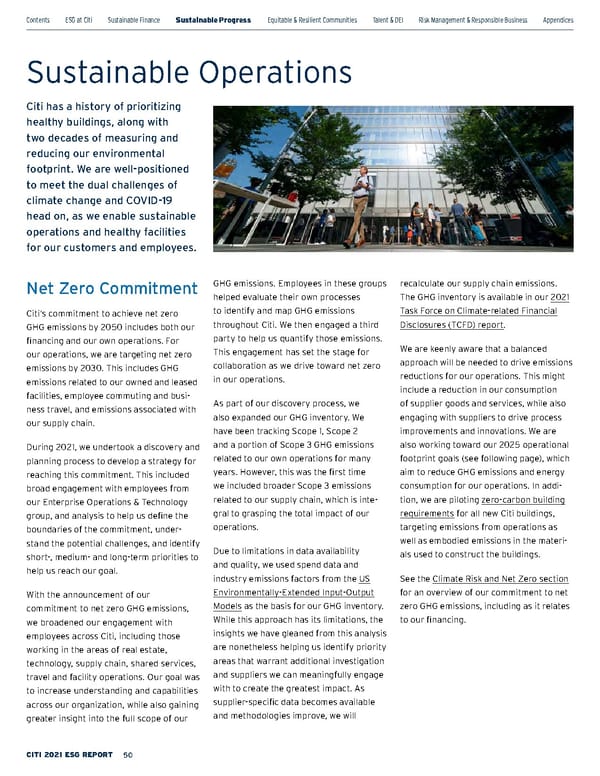Sustainable Operations Citi has a history of prioritizing healthy buildings, along with two decades of measuring and reducing our environmental footprint. We are well-positioned to meet the dual challenges of climate change and COVID-19 head on, as we enable sustainable operations and healthy facilities for our customers and employees. Net Zero Commitment Citi’s commitment to achieve net zero GHG emissions by 2050 includes both our financing and our own operations. For our operations, we are targeting net zero emissions by 2030. This includes GHG emissions related to our owned and leased facilities, employee commuting and busi - ness travel, and emissions associated with our supply chain. During 2021, we undertook a discovery and planning process to develop a strategy for reaching this commitment. This included broad engagement with employees from our Enterprise Operations & Technology group, and analysis to help us define the boundaries of the commitment, under - stand the potential challenges, and identify short-, medium- and long-term priorities to help us reach our goal. With t he a nnouncement o f o ur commitment t o n et z ero G HG e missions, we b roadened o ur e ngagement w ith employees a cross C iti, i ncluding t hose working i n t he a reas o f r eal e state, technology, su pply c hain, s hared s ervices, travel a nd f acility o perations. O ur g oal w as to in crease u nderstanding a nd c apabilities across o ur o rganization, w hile a lso g aining greater i nsight i nto t he fu ll s cope o f o ur GHG e missions. E mployees i n t hese g roups helped e valuate t heir o wn p rocesses to i dentify a nd m ap G HG e missions throughout C iti. W e t hen e ngaged a t hird party t o h elp u s q uantify t hose e missions. This e ngagement h as s et t he s tage f or collaboration a s w e d rive t oward n et z ero in o ur o perations. As part of our discovery process, we also expanded our GHG inventory. We have been tracking Scope 1, Scope 2 and a portion of Scope 3 GHG emissions related to our own operations for many years. However, this was the first time we included broader Scope 3 emissions related to our supply chain, which is inte - gral to grasping the total impact of our operations. Due to limitations in data availability and quality, we used spend data and industry emissions factors from the US Environmentally-Extended I nput-Output Models as the basis for our GHG inventory. While this approach has its limitations, the insights we have gleaned from this analysis are nonetheless helping us identify priority areas that warrant additional investigation and suppliers we can meaningfully engage with to create the greatest impact. As supplier-specific data becomes available and methodologies improve, we will recalculate our supply chain emissions. The GHG inventory is available in our 2021 Task Force on Climate-related Financial Disclosures (TCFD) report . We are keenly aware that a balanced approach will be needed to drive emissions reductions for our operations. This might include a reduction in our consumption of supplier goods and services, while also engaging with suppliers to drive process improvements and innovations. We are also working toward our 2025 operational footprint goals (see following page), which aim to reduce GHG emissions and energy consumption for our operations. In addi - tion, we are piloting zero-carbon b uilding requirements for all new Citi buildings, targeting emissions from operations as well as embodied emissions in the materi - als used to construct the buildings. See the Climate Risk and Net Zero section for an overview of our commitment to net zero GHG emissions, including as it relates to our financing. Contents ESGatCiti SustainableFinance SustainableProgress Equitable&ResilientCommunities Talent& DEI RiskManagement&ResponsibleBusiness Appendices CITI 2021 ESG REPORT 50
 Citi ESG Report Page 49 Page 51
Citi ESG Report Page 49 Page 51